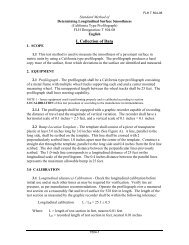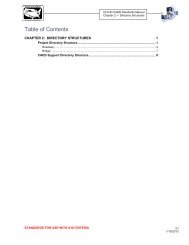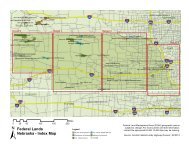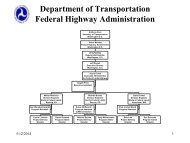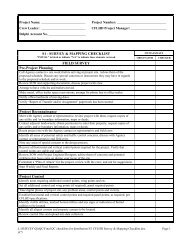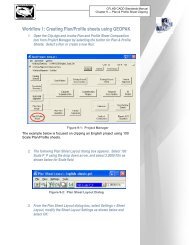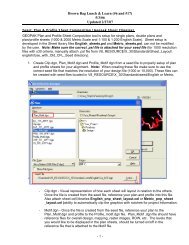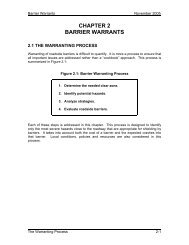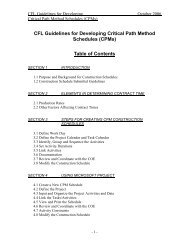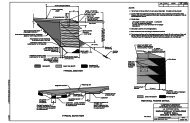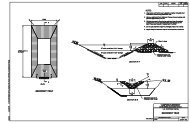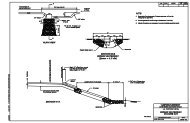55 CHAPTER 6 â PAVED AND UNPAVED ROAD SECTIONS This ...
55 CHAPTER 6 â PAVED AND UNPAVED ROAD SECTIONS This ...
55 CHAPTER 6 â PAVED AND UNPAVED ROAD SECTIONS This ...
You also want an ePaper? Increase the reach of your titles
YUMPU automatically turns print PDFs into web optimized ePapers that Google loves.
<strong>CHAPTER</strong> 6 – <strong>PAVED</strong> <strong>AND</strong> UN<strong>PAVED</strong> <strong>ROAD</strong> <strong>SECTIONS</strong>layer. Recently, Giroud and Han (2004a and 2004b) proposed a new empirical designmodel for geogrid reinforced unpaved roads, based in part on lab model tests that werereported by Gabr (2001). <strong>This</strong> model accounts for aggregate base course deterioration asthe number of traffic loading cycles increase, and, while developed for a rut depth of 75mm (3 in), allows for the input of different rut depth values, and is calibrated for ageogrid’s aperture stability modulus (ASM). In their closure to the paper (Giroud andHan, 2006), defended the use of ASM, comparing traffic benefit ratios of reinforcedunpaved roads measured by Watts et al. (2004) to 5% secant moduli for the geogridsused. Based on those measurements, it was noted that there was no correlation, that theaverage strains mobilized in the geogrids ranged from 0.1 to 1.2% and ASM is a betterindicator to use in this case.Tingle and Webster (2003) back-calculated bearing capacity factors using results fromfour test sections subjected to simulated traffic loading, observing rut depths up to threeinches. Finite element analysis of unpaved road sections were performed by Perkins etal. (2005b) and Leng and Gabr (2002) and attempted to explain the contribution ofgeosynthetics to increasing the service life of the unpaved section. Leng and Gabr (2005)also presented a design model that estimates the benefits realized in an unpaved sectionwith inclusion of reinforcement. The model includes effect of level of mobilization ofsubgrade bearing capacity as a function of rutting as well as relative aggregate basecourse to subgrade modulus ratio.Gaps in Our KnowledgeThe recent methods proposed by Giroud and Han (2004a and 2004b) are largelyuncalibrated. In their closure (2006) the authors mention that more than 20 paved roaddesigns have since been implemented using their methods. Such database needs to beconsiderably increased, with long term monitoring and model verification for wideacceptance of the proposed approach.The numerical finite element studies reported in literature may be a first step toward amore mechanistic-based design model. These methods, however, are unlikely to maketheir way into common practice unless (i) the interface between user and finite elementmodel are more stream lined and user friendly, (ii) interface and material models areaccepted and (iii) the results are well correlated to measured behavior. So far, the finiteelement studies have provided design charts that are dependent on the type ofreinforcement modeled and the initial boundary conditions assumed.CONSTRUCTION PLATFORMS (TEMPORARY UN<strong>PAVED</strong> <strong>ROAD</strong>S)Temporary unpaved roads have different design requirements than permanent ones.Often times, they are placed simply for construction access, so the rut depths can belarger under lower number of passes by traffic (albeit heavier load). From a FLHDstandpoint, these projects may also be considered within the realm of contractor designbuildarrangement.64



